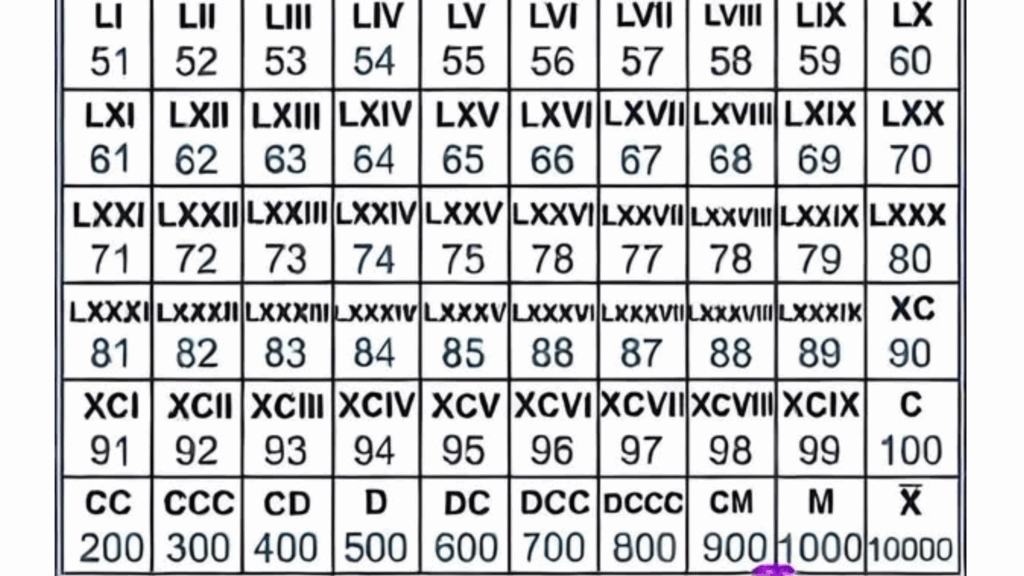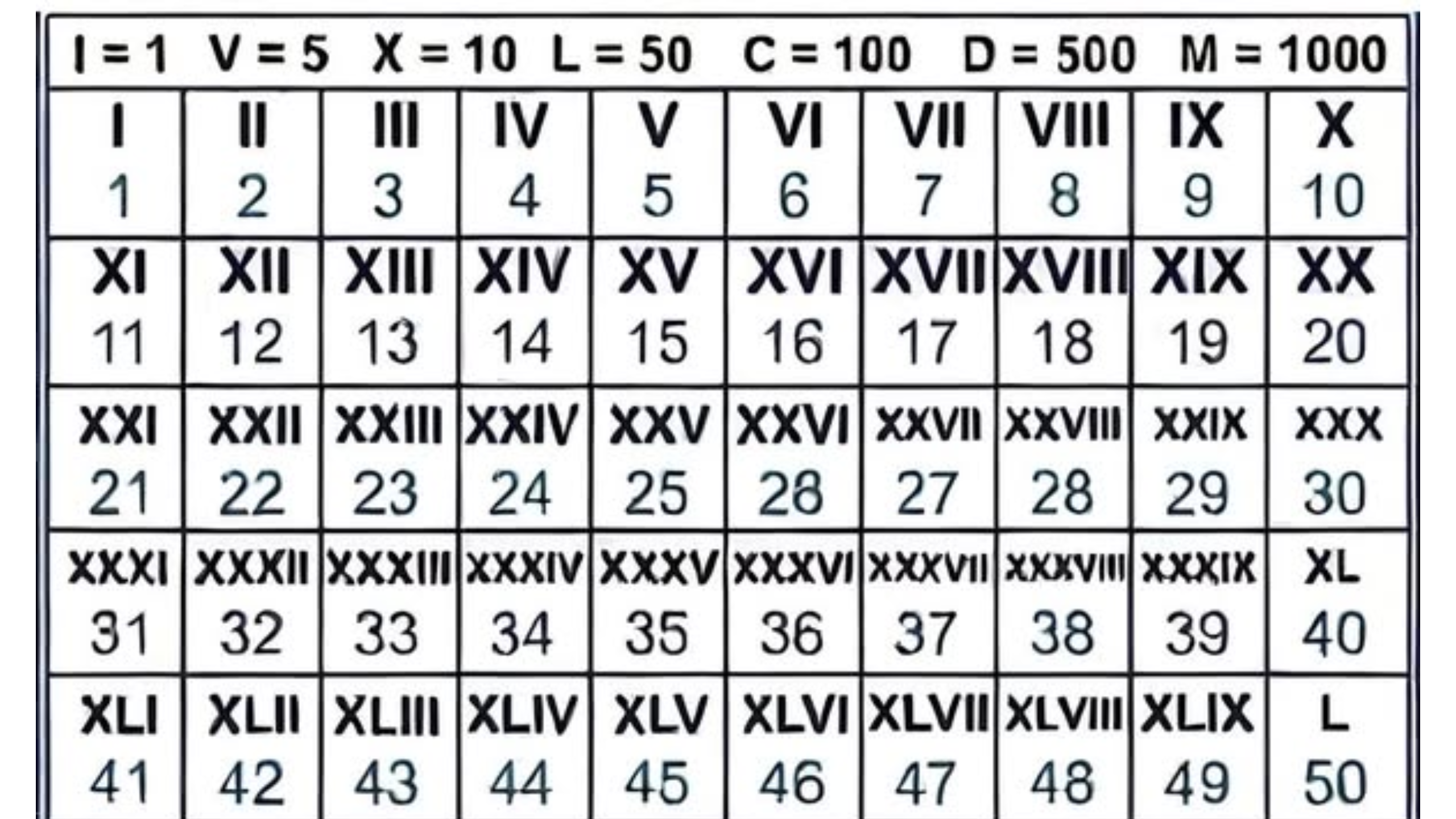Roman numerals may seem old-fashioned at first glance, but they still play a meaningful role in our everyday lives. Whether you’re reading a clock, deciphering Super Bowl numbers, or identifying monarchs and popes, understanding Roman numerals can be surprisingly useful—and even fun.
In this article, you’ll learn how to read, write, and understand Roman numerals with ease. We’ve broken everything down into simple parts, so even beginners can master this timeless number system. Let’s dive in!
What Are Roman Numerals?
Roman numerals originated in ancient Rome, long before our current number system (known as Arabic numerals) became widespread. Instead of using place value like “1, 10, 100,” Roman numerals use combinations of letters from the Latin alphabet to represent values.
Here are the core symbols:
- I = 1
- V = 5
- X = 10
- L = 50
- C = 100
- D = 500
- M = 1000

All other numbers are formed by combining these letters.
How Roman Numerals Work
Roman numerals follow a set of rules that make them both structured and logical. The chart you see above (from 1 to 1000) showcases how numbers are constructed.
Basic Principles
- Letters are added together:
- VI = 5 + 1 = 6
- XV = 10 + 5 = 15
- LXX = 50 + 10 + 10 = 70
- When a smaller number comes before a larger one, subtract it:
- IV = 5 – 1 = 4
- IX = 10 – 1 = 9
- XL = 50 – 10 = 40
- When a smaller number comes after a larger one, add it:
- XI = 10 + 1 = 11
- CX = 100 + 10 = 110
- MVI = 1000 + 5 + 1 = 1006
Examples from the Chart
Let’s take a few examples directly from the chart to understand how these numbers are built:
- 28 = XXVIII (10 + 10 + 5 + 1 + 1 + 1)
- 49 = XLIX (50 – 10 = 40; 10 – 1 = 9)
- 93 = XCIII (100 – 10 = 90; then add 3)
- 400 = CD (500 – 100)
- 900 = CM (1000 – 100)
Why Are Roman Numerals Still Used?
Despite being over 2,000 years old, Roman numerals are still very visible today. Here’s where you’re likely to encounter them:
- Clocks and watches: Many classic clock faces use Roman numerals.
- Movies and TV shows: You’ll often see Roman numerals in copyright dates.
- Book chapters: Many authors use them to number chapters or prefaces.
- Events: The Olympic Games and Super Bowl use Roman numerals for edition numbers.
- Royalty and Popes: Names like Queen Elizabeth II or Pope John Paul II rely on Roman numerals.
They’re also used in architecture, monuments, and legal documents to maintain tradition and formality.
Tips for Learning Roman Numerals
Learning Roman numerals doesn’t have to be intimidating. Here are a few tips:
- Use the chart: Refer to the 1–1000 chart regularly. Visual repetition helps.
- Practice in real life: Try identifying Roman numerals on clocks, buildings, and books.
- Break it into chunks: Learn 1–10, then 10–50, and so on. Building in layers is more manageable.
- Quiz yourself: Cover the chart and try converting numbers both ways—from Roman to modern and vice versa.
Fun Fact: Why Is 4 Sometimes Shown as IIII Instead of IV?
You might notice that on some clocks, the number 4 is written as IIII instead of IV. This isn’t a mistake—it’s a stylistic choice. Ancient clockmakers often used IIII to create visual balance with the VIII on the opposite side of the clock face.
Common Mistakes to Avoid
When learning Roman numerals, beginners often make these mistakes:
- Writing “IIII” instead of “IV” (except for stylistic reasons, as in clocks)
- Placing smaller values after larger ones incorrectly (e.g., writing IIX for 8 instead of VIII)
- Using too many repetitions (e.g., IIII instead of IV in general use)
Final Thoughts
Roman numerals offer a fascinating glimpse into the past while still remaining relevant today. From reading historic documents to understanding modern references, having a solid grasp of Roman numerals enriches your cultural literacy.


amoxil usa – cost amoxicillin order amoxicillin generic
order fluconazole 100mg – https://gpdifluca.com/# buy fluconazole 100mg online cheap
order cenforce 100mg generic – https://cenforcers.com/# cenforce online
canada cialis for sale – cialis tadalafil 20mg tablets cialis online pharmacy australia
tadalafil review forum – site how to take liquid tadalafil
cheap viagra online australia – https://strongvpls.com/ viagra sale forum
The thoroughness in this draft is noteworthy. https://gnolvade.com/
I couldn’t resist commenting. Warmly written! https://buyfastonl.com/amoxicillin.html
More articles like this would make the blogosphere richer. https://ursxdol.com/get-metformin-pills/
This is the kind of post I find helpful. https://prohnrg.com/product/lisinopril-5-mg/
This is the big-hearted of criticism I rightly appreciate. https://aranitidine.com/fr/sibelium/
The thoroughness in this break down is noteworthy. https://ondactone.com/product/domperidone/
The sagacity in this piece is exceptional. buy domperidone
Greetings! Very serviceable recommendation within this article! It’s the crumb changes which liking make the largest changes. Thanks a lot in the direction of sharing! https://myrsporta.ru/forums/users/ehprt-2/
order dapagliflozin 10mg generic – https://janozin.com/# purchase dapagliflozin online
buy xenical generic – where to buy xenical without a prescription cost orlistat 60mg
More articles like this would make the blogosphere richer. http://bbs.51pinzhi.cn/home.php?mod=space&uid=7113294
You can conserve yourself and your dearest by way of being alert when buying prescription online. Some pharmacopoeia websites operate legally and offer convenience, solitariness, cost savings and safeguards as a replacement for purchasing medicines. buy in TerbinaPharmacy https://terbinafines.com/product/norvasc.html norvasc
You can protect yourself and your dearest by way of being alert when buying pharmaceutical online. Some pharmaceutics websites operate legally and provide convenience, secretiveness, bring in savings and safeguards over the extent of purchasing medicines. buy in TerbinaPharmacy https://terbinafines.com/product/decadron.html decadron
Palatable blog you possess here.. It’s hard to find strong quality script like yours these days. I really appreciate individuals like you! Withstand care!! where to buy rivastigmine without a prescription
You can protect yourself and your stock nearby being wary when buying prescription online. Some druggist’s websites manipulate legally and put forward convenience, solitariness, rate savings and safeguards for purchasing medicines. http://playbigbassrm.com/
Thanks on putting this up. It’s understandably done.
https://t.me/s/lex_officials
Wenn Sie im Raging Bull Online Casino spielen, werden Sie mit animierten Grafiken und visuellen Effekten begeistert sein. Dieses Casino ist ein sicher Ort zu spielen – es besitzt eine Curacao Lizenz für seine Aktivität. Raging Bull Online Casino ist auf amerikanische Kunden ausgerichtet, aber die Spieler auf der ganzen Welt können Raging Bull Online Casino spielen. Sicherlich hat jedes Casino seine Vorteile, die uns im Laufe der Zeit gefallen und wegen denen wir immer genau in diesem oder jenem Casino spielen. Raging Bull Casino ist ein großartiger Ort, um zusammen mit dem 2024 Bonus Spaß beim Spielen von Casinospielen zu haben. Möchtest du Books & Bulls um Echtgeld spielen, wechselst du einfach in das Online Casino in den Echtgeldmodus und zahlst deinen gewünschten Betrag ein.
Bull Casino bietet ein umfangreiches Spielerlebnis mit modernen Slots, spannenden Live-Games und einem großzügigen Willkommensbonus. Spiele unterhalten, aber Verluste können passieren.
Mehr Buch Action gibt es amBook of Dead Spielautomat, amBook of Ra Spielautomatoder beimRamses Book online spielen. Du erhältst dann 10 free Spins und das Buch enthüllt wie bei Bücherslots üblich ein Symbol, das während der Freispiele zum Bonus Symbol wird. Beim Books and Bulls spielen wirst du schnell feststellen, dass es sich nicht um einen klassischen Buchslot handelt. Die Glücksspieler aus Deutschland erhalten Zugang zu über 300+ neuesten Spielautomaten, professionellen Bewertungen sowie zuverlässigen und unvoreingenommenen Bewertungen zahlreicher internationaler Casinos. Eine weitere Sache ist, dass Sie online und mit echten Spielern im Casino spielen.
References:
https://online-spielhallen.de/jet-casino-aktionscode-ihr-umfassender-leitfaden/